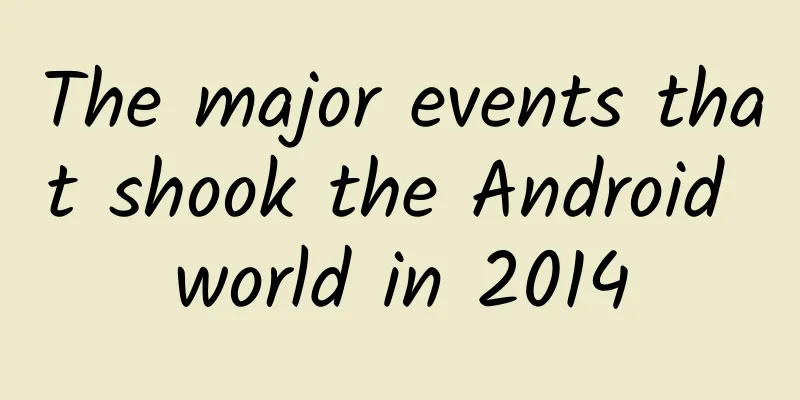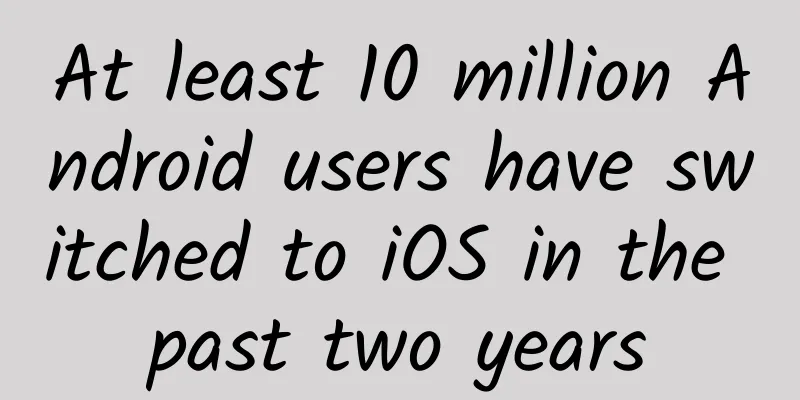The major events that shook the Android world in 2014

|
In the past few years, the Android camp seems to have bid farewell to its initial courageous progress and has shown a calm and steady forward trend. Admittedly, a series of software updates and product releases are still going on as usual, but it seems difficult to find truly exciting and revolutionary achievements that even make the audience stand up and applaud. What's worse is that the control of Android has gradually flowed out of Google's hands and gradually fallen into the hands of other camp members, and the most representative ruler among them is the Korean electronics giant Samsung. Who is the real master of Android - the developer or the device supplier? I'm afraid it's difficult for everyone to find an accurate answer. However, in 2014, Android finally ushered in a series of profound changes that users have been waiting for for a long time. In order to commemorate these twelve months full of news and changes, we will use today's article to summarize the most influential news of the year, so as to help everyone more comprehensively and accurately understand the changes that have taken place in the Android ecosystem during this extraordinary period. 64-bit mobile processor The 64-bit mobile processor is a bombshell for the Android camp. Nvidia started 2014 with a big announcement, announcing its Tegra K1 project. 32-bit derivatives of the project eventually appeared in the Shield Tablet and Tango, but the 64-bit version didn't make its debut until HTC launched the Nexus 9. Qualcomm also took steps to build 64-bit processors in the past year, but its entry point was chosen at the lower performance end of the stack, so the actual impact was somewhat muted. Qualcomm's high-end 64-bit Snapdragon processors will not be officially launched until early 2015. However, 64-bit chips alone are not enough to solve all problems. We also need a 64-bit mobile operating system to interact with it. In view of this, Google has timely released Android Lollipop, a new version that is optimized for the new ARMv8 64-bit standard. The potential benefits of bringing 64-bit to mobile processors have yet to be fully realized, but with the Nexus 9 shipping with this new processor type, we should see more Android developers rewriting their apps to take advantage of the new ARMv8 instruction set. Lenovo acquires Motorola
Lenovo began acquiring Motorola, a long-established mobile giant, in early 2014, but the deal was not fully completed until the end of the year. Before it actually happened, few people could have predicted such a situation. Lenovo, one of the world's largest PC manufacturers and the fourth largest smartphone manufacturer, announced at the end of January 2014 that it would acquire Motorola for $2.91 billion. However, the acquisition was not completed until the end of October 2014, and we still don't know what impact this transaction will have on Motorola, or whether the two companies will proceed with the business integration plan. We may witness the actions of both parties during the smartphone release cycle next year to get more solid evidence related to this merger. Google puts pressure on Samsung and other OEMs to control
Google has begun to work on getting major OEM manufacturers, represented by Samsung, to return to Android's established development strategy, rather than continuing to act independently and go their separate ways. Around the same time as Lenovo’s Motorola acquisition, Recode reported that Google was pressuring Samsung to limit changes to Android and app bloat. We saw the results of this secret agreement later, with the Galaxy S5 launching a slightly stripped-down version of TouchWiz Nature UX, and other apps and features that were installed by default on earlier models becoming optional downloads. Other OEMs followed Google’s lead, such as LG and HTC, and every new Android phone you buy now has a “Powered by Android” logo to emphasize Google’s influence. This control game will become more apparent in the Android camp in the new year. #p# Other projects in the Android space
The Ara project, a modular smartphone created by Google, is clear proof that Android is destined to bring more and richer technological achievements. Both Tango and Ara are Android-based "projects," but their reasons for existence and starting points are very different: Tango is essentially a spatial perception device that can create a 3D map of the surrounding environment; while Ara is a modular smartphone that allows users to hot-swap multiple components. But what they have in common is that they both mark the established direction of the next development of Android devices. We know that NASA has already built some pretty impressive developments with Project Tango, and we believe Google will use Project Ara as an opportunity to announce more exciting news at its second annual Developer Conference in January. BlackPhone, Cyanogen, and other forks
OnePlus carries extremely high market expectations, but there is still a lot of work to be done before the Android fork can be standardized. The year 2014 was not only significant for Google's Android, but also for a number of new Android forks. Cyanogen, BlackPhone and even Nokia are all working on their own new versions of the operating system based on the Android Open Source Project (AOSP), hoping to gain a certain share of the market and help these users get mobile design results that are different from the mainstream solutions. But while the Android fork space is thriving, it still has a long way to go before it can truly enter the mainstream and gain widespread acceptance, and negative press will only slow that progress. OnePlus, for example, has struggled over the past year due to its bizarre sales tactics, not to mention its offensive marketing campaign a few months ago. Microsoft, for its part, is quietly thwarting Nokia's Android ambitions by refusing to include products like the Nokia X in its future plans. That's it. Whether this fork trend can become mainstream in the United States depends on whether the relevant companies can come up with outstanding results that can compete head-on with Android. One thing is certain: we will witness the emergence of more forks in the new year. Android Wear
Android Wear is an important step taken by the Android camp in the wearable strategy field in 2014. The truth is finally revealed: Google Glass is not part of Google's wearable device development strategy at all. Android Wear, which debuted in March 2014, is the new standard for wearable operating systems that Google is really working on. The best part about Android Wear is that, like the Android operating system on mobile phones, it is open to device manufacturers, allowing them to create completely different watch products. As a result, you can now buy smart watches from manufacturers such as Samsung, Sony, LG, Motorola and even Asus. Google I/O 2014
Google made so many announcements about Android at Google I/O that it felt like they needed to devote their own conference to the operating system. June 2014 was a big month for Android. Google made a number of announcements at its annual Google I/O conference, including: Android One: The announcement of Android One marks the development of an emerging market outlined by Android development team leader Sandar Pichai. Rather than letting all OEMs continue to launch a large number of low-level customized Android versions based on AOSP, Google prefers to work with partners to release cheap mobile phones running a standardized Android system with all common Google services. Many mobile device manufacturers, including ASUS, HTC and Lenovo, have decided to participate in the Android One project, which also ensures that their products will always have a consistent pace of software updates for up to two years. Android 5.0 Lollipop: We didn't know what the latest version was called until it was officially released in October 2014. But Lollipop proved to be the biggest and most important version of Android yet, with a dramatic UI overhaul that took the drab "Holo" look into a colorful new era. Our full review of the OS further confirmed its fresh and ambitious features. Android Auto: We're not exaggerating when we call Google I/O the biggest Android event of 2014. The event also saw the announcement of Android Auto, Google's effort to bring automakers into its new "Android on everything" strategy. It is very easy to use: all we need to do is connect our phone to a compatible in-car entertainment system. Currently, more than 25 car brands have joined the Android Auto family, and more members will be unveiled in the future. So far, although Android Auto is still in the beta testing stage, Honda Civic and Hyundai Sonata have already started to implement the solution. Android TV: Android TV is a big surprise, as Google has planned to completely abandon all development plans around Google TV. Android TV claims to be an alternative to Google TV, and Google hopes that this project will bring Google applications and services beyond the user's living room and further simplify the difficulty for developers to develop applications for TV screens. Android TV will eventually be built into TVs and set-top boxes, but now we can experience the use of Android TV first by purchasing Nexus Player. #p# Material Design
Material design style is the latest design paradigm adopted by Android, and its visual effect is quite gorgeous. Material Design is a new design standard for Android, or what I like to call an "overall upgrade to Android." Google's suite of apps now fully match the new interface and color scheme, but other third-party Android apps have been slower to adjust. And in addition to the full push at Google I/O, Material Design became a hot topic in 2014 because it played an important role in the overall transformation of Android. We've already covered the Material Design changes in our previous Lollipop review. Google is still adapting its apps to these new standards, and it seems like core apps like Hangouts and Google+ are seeing several new changes to their look and functionality every week. Other developers are also gradually updating their apps to look and feel more like the Material Design standard. As a result, our Android phones are starting to look, feel, and work in a more logical and consistent way. Comprehensive management restructuring Google completed a series of major management reshuffles in 2014, although not all of the departures were directly related to the Android development team.
Google's Sundar Pichai has been promoted to head of the Android product team. Let's start with Sundar Pichai: He started to lead both Chrome OS and Android in 2014, and is now Google's product chief, leading Android, Chrome, and Google Apps. This decision was made because Google was concerned that its product fragmentation would hurt the innovation of a single solution over time. With Pichai at the helm, we are looking forward to seeing what kind of development Google will usher in in the field of software and product ecosystem.
Andy Rubin's departure leaves us with a mystery that is difficult to answer. The next big bombshell in the reorganization was the departure of Andy Rubin, who co-founded and later headed Google's Android division, but unexpectedly moved to the Google X robotics team as his career progressed. His departure was a shock, although Google promised that the personnel changes would not have any negative impact on the operation and future development of the robotics department.
Google says Vic Gundotra's departure does not mean the end of Google+. Finally, Vic Gundotra left the Google+ team to pursue new opportunities. His departure has caused many people to worry about the future of Google+. We are still waiting to see what the actual consequences will be, because to be honest, Google has not been able to make any real progress in the social networking field since Gundotra left. Android's dominance remains strong Despite a series of major changes and restructuring, Android still firmly holds its position as the global mobile king. According to a survey by analysts at IDC, by the end of 2014, it is estimated that more than one billion Android phones will be sold throughout the year. This is equivalent to 82.3% of the total smartphone market share worldwide - a very impressive proportion. 2014 can be regarded as the year of strategic transformation for Google Android. Android devices on the market are still diverse and varied, and use a large number of tools to help developers obtain a simple and feasible application creation experience, but this camp has begun to show a unified evolution trend. We are also very curious about how third-party OEMs will respond to these changes and whether the diverse fork devices can find their own correct development path in the new year. There is no doubt that all of this will become the main industry trend that will accompany us in 2015. Original link: http://www.pcworld.com/article/2858889/2014-in-review-the-year-in-android.html |
<<: "O" your head! A list of the dead O2O projects in 2014
>>: Mail App Mail Master gives you a quick red envelope so you can take a taxi at will
Recommend
Red Planet's "Introduction to Short Videos in Physical Stores" - How to shoot and edit ideas, Dou+ delivery, etc.
Course Contents: Introduction to short videos in ...
Brand Marketing: Event Calendar and Promotion Planning
For the overall management of e-commerce promotio...
Short video operation topic planning!
In this article, we will share with you from thre...
A 50s geek's adventurous life with radio
[Key points] Zeng Dejun, born in the 1950s, was bo...
Ma Ge Python Full Stack + Crawler + Data + AI [2022]
Ma Ge Python Full Stack + Crawler + Data + AI [20...
4 Tips for Analyzing Peers in SEO!
1. Visit the competitor's website as a visito...
How can a small brand turn into a big brand?
In the past, if a small brand wanted to turn arou...
Tmall 618 Shopping Festival promotion activities to make huge profits
Tmall 618 Shopping Festival promotion activities,...
Summary of myofascial chain rehabilitation techniques (must be mastered by rehabilitation therapists)
Summary of myofascial chain rehabilitation techni...
Rules for Juliang Qianchuan Advertising and Direct Broadcasting
What traffic dividends does Qianchuan Search have...
The evolution and thinking of Taobao Native R&D model
The origin and development of DX DX was hatched f...
How to increase the activation rate of information flow advertising?
How to increase activation volume ? Similar quest...
Wuxi Guoda Machinery Equipment Co., Ltd. SEO optimization training case
Wuxi Guoda Machinery Equipment Co., Ltd. is a for...
Swift Community Survey: What do we expect Swift 3.0 to look like?
[[155457]] With the release of powerful new featu...
Lu Mingming · WeChat Group Precision Traffic Drainage Training Camp 3.0, using WeChat groups to conduct traffic diversion operations and create a private domain traffic pool
Lu Mingming · WeChat Group Precision Traffic Drai...









